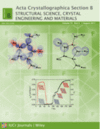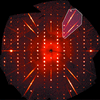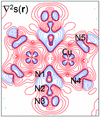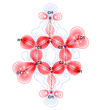issue contents
August 2017 issue
Special issue on charge density, photocrystallography and time-resolved crystallography: a tribute to Professor Philip Coppens
Guest Editors: Claude Lecomte, Jason Benedict and Yu-Sheng Chen

Cover illustration: Images illustrating charge and spin density, and photocrystallography taken from Voufack et al. [(2017). Acta Cryst. B73, 544-549], Mariette et al. [(2017). Acta Cryst. B73, 660-668] and Stachowicz et al. [(2017). Acta Cryst. B73, 643-653].
preface
Free 

Philip Coppens describes this special issue on charge density, photocrystallography and time-resolved crystallography.
introduction
Free 

This article introduces a special issue dedicated to a lifetime of outstanding scientific achievements by Professor Philip Coppens.
Philip Coppens tribute
The present state of X-ray electron-density determination from powder-diffraction data is briefly reviewed together with the first results from a new large-diameter in-vacuum diffractometer.
In experimental charge-density investigations, it is essential to reach the highest possible quality of data and the most resilient model. Recent developments concerning data and model quality are reviewed.
Download citation


Download citation


Experimental joint refinement against X-ray and polarized neutron diffraction data has been performed to simultaneously model the charge and spin density of a free radical; the resulting model challenges density functional theory (DFT) calculations, but is in fair agreement with ab initio complete active-space self-consistent field (CASSCF) calculations.
CCDC reference: 1553900
Download citation


Download citation


A multi-temperature high-resolution diffraction study of a biologically important salt potassium uridine monophosphate, K(UMPH), is reported. Anharmonic motion in the uracil moiety was detected and verified by He-temperature X-ray diffraction experiments. The charge density distribution was modelled within the Hansen–Coppens formalism, while anharmonicity was taken into account using Gram–Charlier parameters.
Electron spin density at a point may be seen as determined by a local Source Function for such density, operating at all other points of space. Integration of the local source over Bader's quantum atoms measures their contribution in determining the spin density features at any system's location. This novel tool is able to provide interesting insights on the electron spin delocalization and polarization mechanisms along with their dependence from the spin density quality.
Download citation


Download citation


This paper reports on the determination of charge density distributions from crystals compressed at high pressure. Although much less accurate than traditional charge density analysis, these studies provide valuable information because the electronic states of molecules confined in highly condensed space are not easily predictable by theory and therefore experimental validation is a must.
University at Buffalo DataBank (UBDB)-derived electrostatic energies ( ) closely approach those computed using quantum mechanics mainly because the UBDB allows for a direct account of charge penetration effects. For interactions between polar molecules, penetration constitutes up to 50% of Ees, but for nonpolar molecules, it may reach 100% of Ees at the equilibrium distance.
) closely approach those computed using quantum mechanics mainly because the UBDB allows for a direct account of charge penetration effects. For interactions between polar molecules, penetration constitutes up to 50% of Ees, but for nonpolar molecules, it may reach 100% of Ees at the equilibrium distance.
A spherical-electron-density database with additional spherical scattering centres located on bonds and lone-pair sites is created for charge-density modelling.
Download citation


Download citation


The appearance of an elusive S—H⋯S hydrogen bond with the S atom acting as a donor in 2-, 3-mercaptobenzoic acids has been analysed based on charge density calculations. The importance of the locking potential provided by an intramolecular S⋯O chalcogen bond is highlighted.
Download citation


Download citation


The redox characteristics of pairs of square planar complexes M(mnt)22−/M(mnt)2−, where mnt is the non-innocent maleonitriledithiolate ligand, are established through charge density analysis and X-ray absorption spectroscopy: the oxidation is ligand based in Ni complexes and are metal based for the Cu case.
Download citation


Download citation


F−⋯F− interactions in fluorite have properties associated with the recently recognized type of interaction referred to as `charge-shift' bonding. This finding is supported by the topology of the electron localization function and the analysis of quantum theory of atoms in molecules and crystals. These interactions are attractive in character, which is additionally indicated by the topology of non-covalent interactions based on the reduced density gradient.
CCDC reference: 1555154
Download citation


Download citation


The charge density of 2,5-dichloro-1,4-benzoquinone has been redetermined at 20 K. Two different multipole refinement models lead to similar topological properties of the total electron density.
Broken symmetry and spin-state concentration waves compete during the relaxation from the photoinduced high-spin to the ground low-spin phase of a two-dimensional spin-crossover polymer.
Download citation


Download citation


Dynamic in situ single crystal X-ray diffraction revealed unique and important information about the structural reorganization that occurs upon guest exchange in a cobalt-based metal organic framework.
The need for high-quality assessments of data motivates appreciation of shot noise as a data resource. The index of dispersion is a critical but often overlooked metric in this regard. When properly understood and carefully used it reveals the energies of quanta, in both monochromatic and polychromatic situations. To accomplish this, and in due course its wider application, its conceptual origins and quantitative and physical bounds are identified. Situations are examined that involve large numbers of quanta, but in which individual quanta are below measurement noise threshold. Practical applications are extremely diverse, so relevant considerations and how to use the metric are shown in broad contexts.
We report a new experimental methodology for time-resolved X-ray diffraction after pulsed laser excitation using a gated hybrid pixel X-ray detector with dedicated pump probe mode, and implemented on a laboratory diffractometer.
The crystal symmetry of ferroelectric BaTiO3 is determined by scanning convergent-beam electron diffraction. The results show inhomogeneous symmetry with nanometre-sized regions of almost perfect symmetry interspersed in regions of lower symmetry.
research papers
Download citation


Download citation


Four novel coordination polymers (CPs) assembled with [2,2′-bifuran]-5,5′-dicarboxylic acid (H2L) and metal ions ZnII, CdII or CoII have been successfully synthesized and characterized. It was found that both the metal ion and the crystal structure play important roles for the luminescent properties of CPs.
Download citation


Download citation


A very accurate single-crystal X-ray diffraction study of synthetic pyrope (Mg3Al2Si3O12,  ) at 30 K reveals that residual density features around Mg2+ ions, previously attributed to static disorder, can be better accounted for by anharmonicity/dynamic disorder.
) at 30 K reveals that residual density features around Mg2+ ions, previously attributed to static disorder, can be better accounted for by anharmonicity/dynamic disorder.
CCDC reference: 1545443
Download citation


Download citation


Theoretical and experimental investigations on non-linear optical properties of four metal–organic framework isomorphs, based on fructose and alkali-earth halogenides, show that both the intrinsic nature of the anion and the induced dissociation of the cation and anion by fructose play a role in the second-harmonic generating properties of such compounds.
Download citation


Download citation


In chloro(phthalocyaninato)aluminium, every second double layer is disordered over two positions. The disorder is analysed and explained by order–disorder theory and lattice-energy minimizations using dispersion-corrected density functional theory.
CCDC reference: 1541533
Download citation


Download citation


Two hundred crystal structures with missed symmetry were investigated by dispersion-corrected density functional theory. In 98.5% of the cases the correct space group is found.
Download citation


Download citation


The incommensurately modulated structures of η′′-Cu3+xSi and η′′′-Cu3+xSi are described in the superstructure approximation. The structures are compared.


 journal menu
journal menu













































